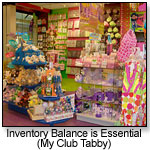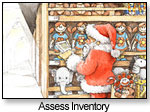 |

Tools:








Make Inventory Work for YouDon't Buy and Sell Like the Big Boys
By its very nature, inventory restricts cash flow.
"A basic inventory at retail price should show you have no more than (twice) your amount of sales for any given month." — Bob Phibbs, the Retail Doctor
"Inventory is the least liquid of all current assets and can tie up your cash indefinitely," says Rosemary Peavler, retired college professor of Business Finance. A substantial sum of money might be sitting in the form of product on your shelves or in your warehouse, waiting to be bought. Until it is, the cash is unavailable. Yet, you don't want to be out of stock and unable to satisfy customer demand, because this also impacts cash flow.
 "Finding the right inventory control balance between how much stock your company needs to meet customer demand and how long it would take suppliers to fill last-minute orders can be tricky, but it is possible," explains Ward. "If you hold too much inventory on your shelves or in your warehouse, you run the risk of obsolescence and getting stuck with inventory that you can't sell. If you hold too little inventory, then you are risking stock outs and loss of customer good will. Either problem will cost your business money." "Finding the right inventory control balance between how much stock your company needs to meet customer demand and how long it would take suppliers to fill last-minute orders can be tricky, but it is possible," explains Ward. "If you hold too much inventory on your shelves or in your warehouse, you run the risk of obsolescence and getting stuck with inventory that you can't sell. If you hold too little inventory, then you are risking stock outs and loss of customer good will. Either problem will cost your business money."
Warning: "Red Flags" Ahead!
Inventory problems manifest as more than just piles of dusty products, and catching early warning signs can enable a retailer to take action before it's too late.
Kurt Clark, directory of The Alliance Small Business Development Cwenter (SBDC), advises to beware if "cost of goods starts going up quickly or … fluctuating significantly month to month; net margins are much lower than projected; and [you have] excessive "stale" or slow selling inventory." Bob Phibbs, the Retail Doctor®, explains that "a basic inventory at retail price should show you have no more than two times your amount of sales for any given month. That means if in your average August, you sell $75,000, you shouldn't have more than $150,000 (of inventory) on hand. If you do, it is a red flag you are probably overbought. I know many in the toy business will say, 'It's OK if I have too much merchandise; it will all sell at Christmas.' That isn't always true and whatever you brought in June because you got a 5% discount or free shipping could easily be shopworn, stolen, or out of fashion by the holidays. Better to run leaner much of the year and stock up only when demand matches."
Cash Cows vs. Dogs
"Inventory is the least liquid of all current assets and can tie up your cash indefinitely." — Rosemary Peavler, Financial Consultant
Understanding the "age" of your inventory, or how quickly it turns over, is an integral component to proper management. Another way of assessing it is referred to as the inventory-turnover ratio that, according to the Small Business Association, measures how often the inventory is sold and replenished over the course of a year. A product that turns quickly generates cash — hence the familiar term "cash cow." One that turns slowly, or not at all, is a "dog."
How is inventory ratio measured? The standard formula is Net Sales/Inventory = # Times (inventory turns). To calculate the ratio, take the net sales figure from your income statement and the inventory figure from the balance sheet. "Inventory management is critical," says Kate Tanner, owner of Kidstop Toy & Book Store in Scottsdale, Ariz., and Volunteer Chair of ASTRA's board of directors. "You miss turns when you don't reorder or order enough. Turns create profit, and should be monitored quarterly. Dollars per square foot should be calculated yearly. Vendors earn and keep shelf space by having products that perform. Otherwise one must clearance the items and start again. We run a clearance sale starting late December to prepare for Toy Fair and new toys."
Peavler notes that generally, a high inventory ratio implies efficient management and selling of inventory. A low turnover ratio exposes a company to the risk of holding obsolete inventory. Holding excess inventory should only happen for a justifiable reason, such as preparing for the holidays. Usually, the faster a store's inventory turns, the better. Rapid turnover becomes a cash cow, enabling a retailer to generate cash and profits, and to purchase more inventory. Peavler suggests retailers categorize inventory into productive inventory, slow-moving inventory and dead inventory, then deal with the merchandise accordingly.
Productive inventory turns steadily and generates cash. Slow-moving inventory, while still selling, may have a number of factors influencing it, from the gradual obsolescence of reduced popularity, to the economic downturn. Retailers should assess the factors causing the movement, determine if those factors are temporary or long-term, and take necessary actions.
"Some define dead inventory as stock that hasn't sold in 12 months," says Peavler.
 "I define dead inventory as stock that hasn't sold in six months." She advises retailers to mark such items down for quick sale or donate them to charity for a tax write-off. "I define dead inventory as stock that hasn't sold in six months." She advises retailers to mark such items down for quick sale or donate them to charity for a tax write-off.
"Use a point-of-sale system," suggests Tanner. "You must keep totals on inventory, be able to run reports ... It's vital to know your stats and numbers. So many times employees will say, 'Boy, have we been selling that game or some toy' and then you hit search for that toy and you see you have sold three out of twelve in three weeks — that's not blowing an item out." Effective inventory management requires tough love. "Be brutal at assessing your SKUs," Phibbs emphasizes. "Just because you love it or it's cute is no reason to hold on to it. And just because you have a low amount doesn't mean it's sold — they could have been lifted."
He strongly advises that retailers do a physical inventory every year, work with manufacturers to buy back slow-moving product, and buy wisely. "Don't buy 48 because the manufacturer can give you a 5% discount when you only need 12. And don't return to the well and re-order too many times."
"Inventory management affects sales growth, cash-flow requirements and the overall atmosphere of the store," advises Rosenberg. "Stay on top of the inventory, not only on the pure numbers, but also on trends, demand and gut feel. Remember that first, if you don't have the right products, you can't sell the products. Second, if you don't have the cash flow, you can't buy the products. Third, if you can't do either of these, you can't grow."
Buy Smart for Santa
For toy retailers, inventory management can be a delicate dance during the holiday season. But Peavler stresses that retail stores can increase sales revenue during the holidays through smart inventory control.
 "Controlling inventory is especially important during a recession, when consumer spending is low. For many small retail businesses, the holiday period is one of the most important sales periods of the year and can literally make or break the business." "Controlling inventory is especially important during a recession, when consumer spending is low. For many small retail businesses, the holiday period is one of the most important sales periods of the year and can literally make or break the business."
To most effectively manage inventory in context of holiday buying, she suggests retailers develop a holiday sales forecast. "If most of your sales occur during the holidays, then your sales forecast will be different for the holiday period than for other times of the year because your sales are seasonal." She notes that the general sales forecast should be done many months prior to the holiday season. If the economy is in a downturn, the sales forecast should be adjusted to compensate. "Remember the 80/20 rule. About 80% of your sales come from 20% of your inventory."
Identifying the 20% shouldering most of your sales is integral to your inventory control processes. "Buy a good inventory tracking software package," counsels Peavler. "Use a point-of-sale software program that will make adjustments to your inventory at the cash register every time you make a sale."
Inventory also has carrying costs. This is another reason retailers should not allow inventory to sit around for extended periods of time — not only does it tie up capital; it costs additional funds while doing so. Carrying costs include such things as storage for the inventory, insurance and taxes, and losses due to obsolescence or theft. Peavler notes that these costs can range from 20 to 40 percent of inventory value each year, which can quickly erode profits.
Open-To-Buy Planning
Another method to manage inventory planning is "Open to Buy," defined as the process of planning merchandise sales and purchases so that a store has the right number of the right products at the right time. Calculated in either units or dollars, OTB is the difference between how much inventory is needed and how much is actually available. One way of calculating OTB is by using the following formula: OTB = Planned Inventory + Planned Sales + Planned Markdowns - Actual Inventory - Inventory on Order - Actual Sales.
There are a number of OTB programs and articles on the web that can help with this critical planning step (see Sidebar). As with cash flow, it is important to keep a watchful eye on the processes involved in your store. Seeing where and when your money is going and when it flows back ensures that your success or failure will not be left solely to chance.
Other contributors to this article may have included: Julie Adrian • Michaele Birney Arneson • Leigh Au • Christina Chan • Julia Ann Charpentier • Elizabeth Chretien • Virginia Davis • Laurel DiGangi • Zan Dubin Scott • Lisa Durante • Cicely Enright • Margaret H. Evans • Doug Fleener • Diane Franklin • Janie Franz • Dennis Foley • Dennis Furlan • Rosette Gonzalez • Elizabeth Greenspan • Mort Haaz • Sharri Hefner • Terri Hughes-Lazzell • Kyle Hall • Pennie Hoover • Sheri Jobe • Julie L. Jones • Candyce Kornblum • Christine Lebednik • Susan Ledford • Chris Lundy • Susan Maddela • Hans C. Masing • J.D. Meisner • Adeena Mignogna • Catherine Jo Morgan • Claudia Newcorn • Willow Polson • Marie Raven • Kara Revel • Andrew Robinton • Greg Rock • Brenda Ruggiero • Tamara Schuit • Brent Turner • Vanessa VanderZanden • Jodi M. Webb • Stacy Wiebe• Mark Zaslove • Alex Zelikovsky
 Writer's Bio: Writer's Bio: Claudia Newcorn has been a freelance writer and editor for over 10 years, after having spent more than a decade in marketing and product management. She writes for both businesses and individual clients, crafting copy, content and advertising. Her articles appear in newspapers, magazines and specialty publications nationwide (www.acornmarketing.com). She is also the author of an award-winning fantasy fiction book, "Crossover," and several published short stories (www.claudianewcorn.com). Read more articles by this author
THIS BANNER IS AN AD:

• • • • • • • • • • • • • • | • • • • • • • • • • • • • |
Back to TDmonthly's front page
|  |
Advertise on TDmonthly

|

